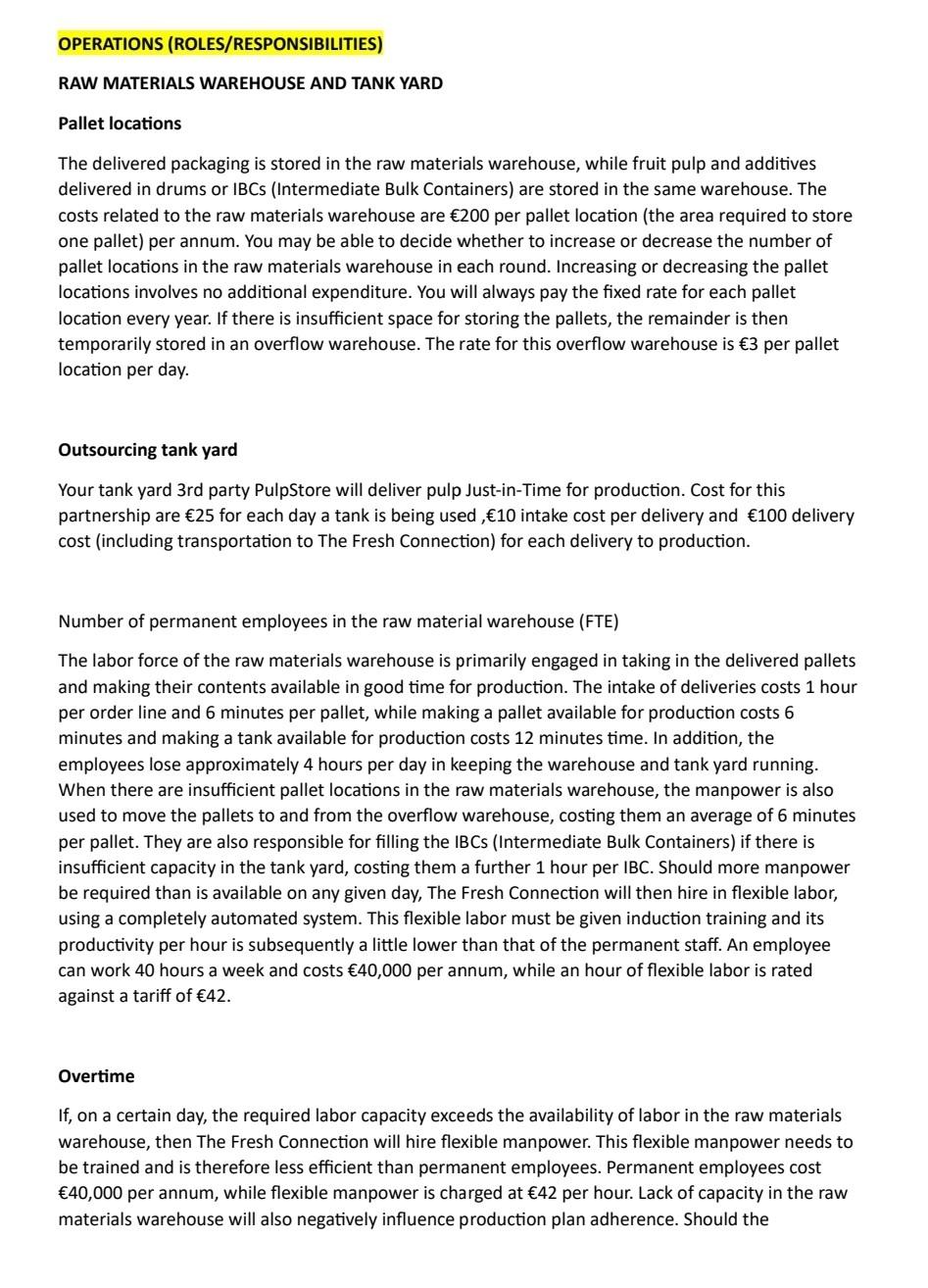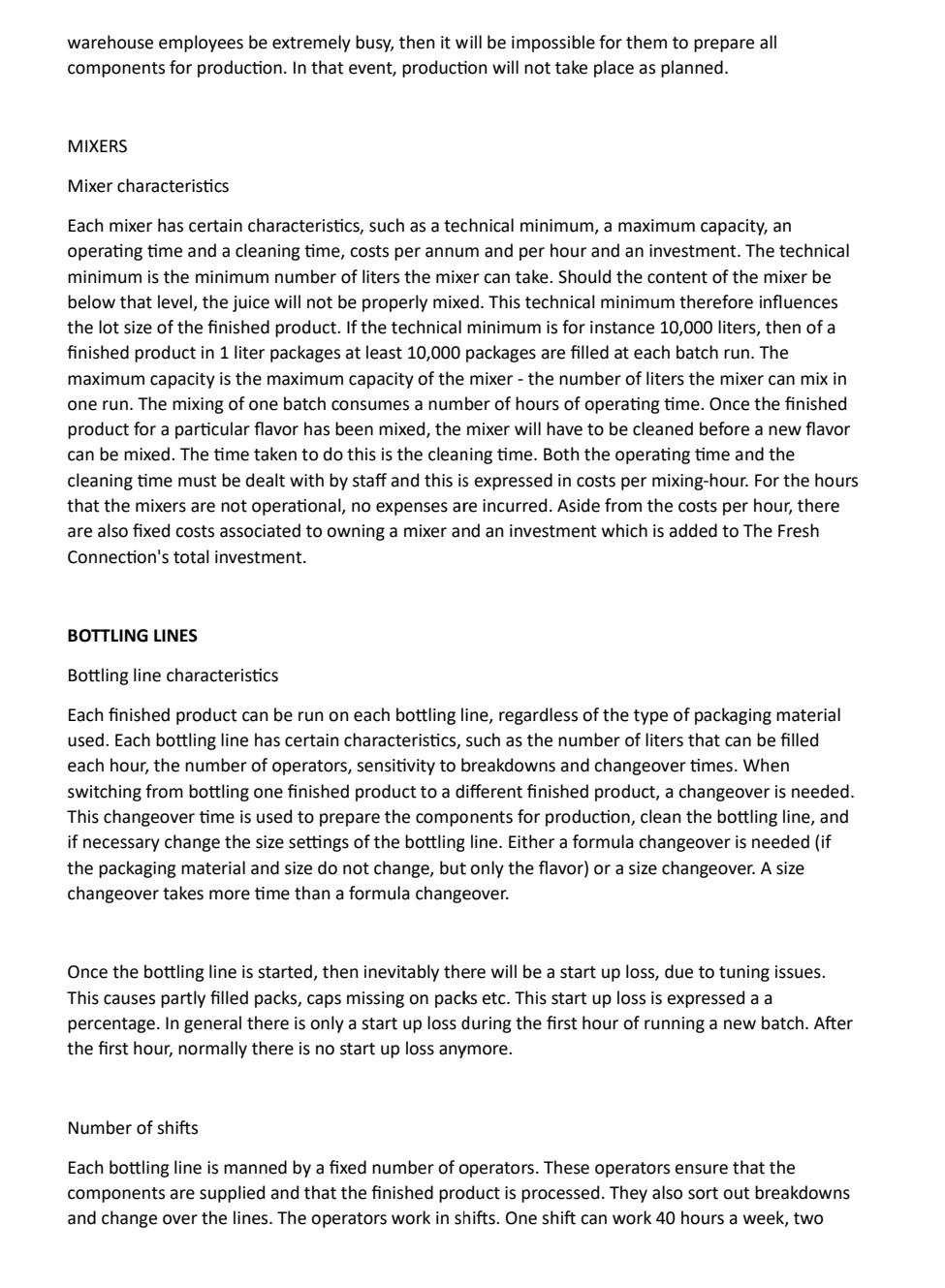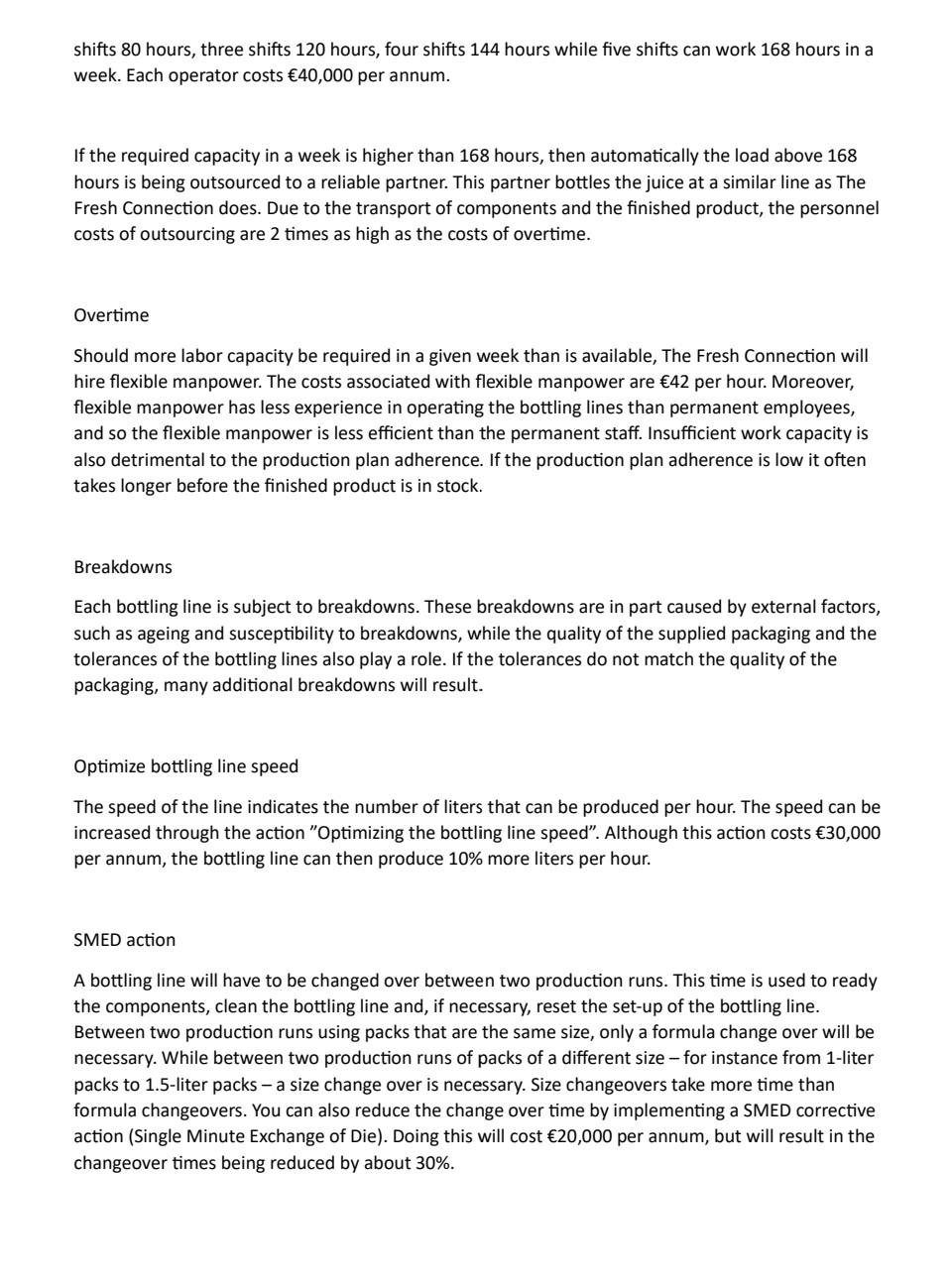Answered step by step
Verified Expert Solution
Question
1 Approved Answer
1) Determine the strategic objective for the above the juice Operations (Refer to the above article). 2) Actions - Inbound pallet places and staff -




1) Determine the strategic objective for the above the juice Operations (Refer to the above article). 2) Actions - Inbound pallet places and staff - Outbound pallet places and staff -Intake time - Shifts production - improvement Projects
warehouse employees be extremely busy, then it will be impossible for them to prepare all components for production. In that event, production will not take place as planned. MIXERS Mixer characteristics Each mixer has certain characteristics, such as a technical minimum, a maximum capacity, an operating time and a cleaning time, costs per annum and per hour and an investment. The technical minimum is the minimum number of liters the mixer can take. Should the content of the mixer be below that level, the juice will not be properly mixed. This technical minimum therefore influences the lot size of the finished product. If the technical minimum is for instance 10,000 liters, then of a finished product in 1 liter packages at least 10,000 packages are filled at each batch run. The maximum capacity is the maximum capacity of the mixer - the number of liters the mixer can mix in one run. The mixing of one batch consumes a number of hours of operating time. Once the finished product for a particular flavor has been mixed, the mixer will have to be cleaned before a new flavor can be mixed. The time taken to do this is the cleaning time. Both the operating time and the cleaning time must be dealt with by staff and this is expressed in costs per mixing-hour. For the hours that the mixers are not operational, no expenses are incurred. Aside from the costs per hour, there are also fixed costs associated to owning a mixer and an investment which is added to The Fresh Connection's total investment. BOTTLING LINES Bottling line characteristics Each finished product can be run on each bottling line, regardless of the type of packaging material used. Each bottling line has certain characteristics, such as the number of liters that can be filled each hour, the number of operators, sensitivity to breakdowns and changeover times. When switching from bottling one finished product to a different finished product, a changeover is needed. This changeover time is used to prepare the components for production, clean the bottling line, and if necessary change the size settings of the bottling line. Either a formula changeover is needed (if the packaging material and size do not change, but only the flavor) or a size changeover. A size changeover takes more time than a formula changeover. Once the bottling line is started, then inevitably there will be a start up loss, due to tuning issues. This causes partly filled packs, caps missing on packs etc. This start up loss is expressed a a percentage. In general there is only a start up loss during the first hour of running a new batch. After the first hour, normally there is no start up loss anymore. Number of shifts Each bottling line is manned by a fixed number of operators. These operators ensure that the components are supplied and that the finished product is processed. They also sort out breakdowns and change over the lines. The operators work in shifts. One shift can work 40 hours a week, two FINISHED GOODS WAREHOUSE Pallet locations The finished goods warehouse is used to store finished product that is ready for delivery. The costs for the finished goods warehouse are 200 for each pallet location per year. You may be able to decide whether to increase or decrease the pallet locations in the finished goods warehouse in each round. Increasing or decreasing the pallet locations does not involve additional expenditure, and you will always pay the fixed rate for each pallet location every year. If there is insufficient space in the finished products warehouse, the rest of the pallets will then be temporarily stored in an overflow warehouse. The rate for this overflow warehouse is 3 per pallet location per day. Permanent employees in finished goods warehouse (FTE) The employees in the finished goods warehouse must store the pallets arriving from production. They also pick the customers' order lines and ready them for end-distribution. Storing the pallets coming from production costs 6 minutes in time for every pallet. The picking costs 10 minutes per order line, 6 minutes per pallet or pallet layer and 3 minutes per outer box. Should there be insufficient pallet locations available in the finished goods warehouse, the staff will then move the pallets to an overflow warehouse. Moving one pallet from or to the overflow warehouse costs 6 minutes. Processing a pallet of obsoletes for destruction takes the same time. In addition, the staff spends 4 hours per day cleaning and tidying up the finished goods warehouse. An employee can work 40 hours a week and costs 40,000 per annum, while an hour of flexible labor costs 42. Overtime If, on a given day, there is a need for more additional labor than is available from the permanent staff, The Fresh Connection will then hire in flexible manpower. This flexible manpower needs to be trained, and is therefore less productive than permanent employees. An hour of flexible labor costs 42. A lack of permanent capacity in the finished goods warehouse is detrimental for the service level towards the customer. If the employees are too busy, then they are not able to prepare all orders for the final distribution in time. shifts 80 hours, three shifts 120 hours, four shifts 144 hours while five shifts can work 168 hours in a week. Each operator costs 40,000 per annum. If the required capacity in a week is higher than 168 hours, then automatically the load above 168 hours is being outsourced to a reliable partner. This partner bottles the juice at a similar line as The Fresh Connection does. Due to the transport of components and the finished product, the personnel costs of outsourcing are 2 times as high as the costs of overtime. Overtime Should more labor capacity be required in a given week than is available, The Fresh Connection will hire flexible manpower. The costs associated with flexible manpower are 42 per hour. Moreover, flexible manpower has less experience in operating the bottling lines than permanent employees, and so the flexible manpower is less efficient than the permanent staff. Insufficient work capacity is also detrimental to the production plan adherence. If the production plan adherence is low it often takes longer before the finished product is in stock. Breakdowns Each bottling line is subject to breakdowns. These breakdowns are in part caused by external factors, such as ageing and susceptibility to breakdowns, while the quality of the supplied packaging and the tolerances of the bottling lines also play a role. If the tolerances do not match the quality of the packaging, many additional breakdowns will result. Optimize bottling line speed The speed of the line indicates the number of liters that can be produced per hour. The speed can be increased through the action "Optimizing the bottling line speed". Although this action costs 30,000 per annum, the bottling line can then produce 10% more liters per hour. SMED action A bottling line will have to be changed over between two production runs. This time is used to ready the components, clean the bottling line and, if necessary, reset the set-up of the bottling line. Between two production runs using packs that are the same size, only a formula change over will be necessary. While between two production runs of packs of a different size - for instance from 1-liter packs to 1.5-liter packs - a size change over is necessary. Size changeovers take more time than formula changeovers. You can also reduce the change over time by implementing a SMED corrective action (Single Minute Exchange of Die). Doing this will cost 20,000 per annum, but will result in the changeover times being reduced by about 30%. OPERATIONS (ROLES/RESPONSIBILITIES) RAW MATERIALS WAREHOUSE AND TANK YARD Pallet locations The delivered packaging is stored in the raw materials warehouse, while fruit pulp and additives delivered in drums or IBCs (Intermediate Bulk Containers) are stored in the same warehouse. The costs related to the raw materials warehouse are 200 per pallet location (the area required to store one pallet) per annum. You may be able to decide whether to increase or decrease the number of pallet locations in the raw materials warehouse in each round. Increasing or decreasing the pallet locations involves no additional expenditure. You will always pay the fixed rate for each pallet location every year. If there is insufficient space for storing the pallets, the remainder is then temporarily stored in an overflow warehouse. The rate for this overflow warehouse is 3 per pallet location per day. Outsourcing tank yard Your tank yard 3rd party PulpStore will deliver pulp Just-in-Time for production. Cost for this partnership are 25 for each day a tank is being used , 10 intake cost per delivery and 100 delivery cost (including transportation to The Fresh Connection) for each delivery to production. Number of permanent employees in the raw material warehouse (FTE) The labor force of the raw materials warehouse is primarily engaged in taking in the delivered pallets and making their contents available in good time for production. The intake of deliveries costs 1 hour per order line and 6 minutes per pallet, while making a pallet available for production costs 6 minutes and making a tank available for production costs 12 minutes time. In addition, the employees lose approximately 4 hours per day in keeping the warehouse and tank yard running. When there are insufficient pallet locations in the raw materials warehouse, the manpower is also used to move the pallets to and from the overflow warehouse, costing them an average of 6 minutes per pallet. They are also responsible for filling the IBCs (Intermediate Bulk Containers) if there is insufficient capacity in the tank yard, costing them a further 1 hour per IBC. Should more manpower be required than is available on any given day, The Fresh Connection will then hire in flexible labor, using a completely automated system. This flexible labor must be given induction training and its productivity per hour is subsequently a little lower than that of the permanent staff. An employee can work 40 hours a week and costs 40,000 per annum, while an hour of flexible labor is rated against a tariff of 42. Overtime If, on a certain day, the required labor capacity exceeds the availability of labor in the raw materials warehouse, then The Fresh Connection will hire flexible manpower. This flexible manpower needs to be trained and is therefore less efficient than permanent employees. Permanent employees cost 40,000 per annum, while flexible manpower is charged at 42 per hour. Lack of capacity in the raw materials warehouse will also negatively influence production plan adherence. Should theStep by Step Solution
There are 3 Steps involved in it
Step: 1

Get Instant Access to Expert-Tailored Solutions
See step-by-step solutions with expert insights and AI powered tools for academic success
Step: 2

Step: 3

Ace Your Homework with AI
Get the answers you need in no time with our AI-driven, step-by-step assistance
Get Started


